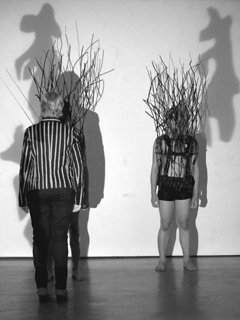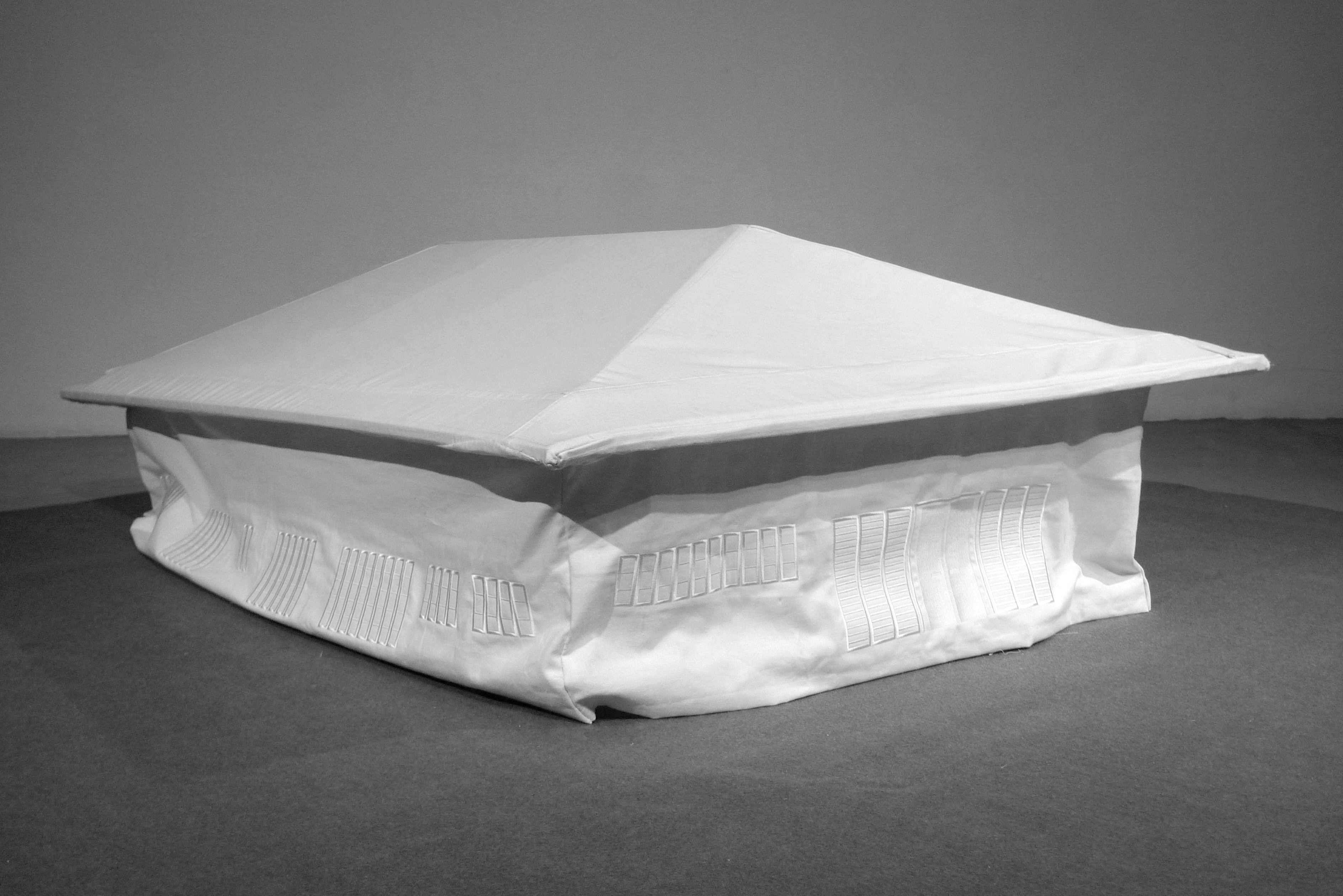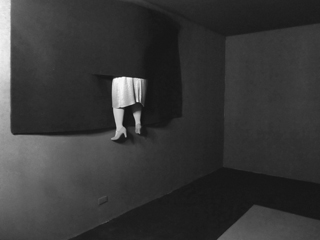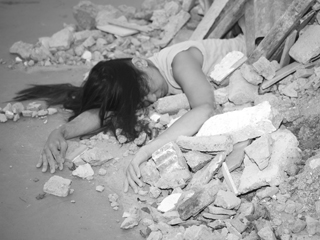The best art, perhaps, is art that raises more questions than it answers. By this standard, the opening of the art exhibit Absence at the Manila Contemporary gallery last Saturday, June 4, may have been performance art of the best kind. Mella Jaarsma

Mella Jaarsma interacting with creatures unknown Vic Sollorano
In an intriguing performance art piece entitled Animals Have No Religion, Indonesian artist Mella Jaarsma’s use of humans in animal garb raised questions that in turn raised our hackles. A couple of human forms were transmuted into four-legged animal forms, with human hands supported by stilt-like appendages. Swathed in leather, both models walked amongst the audience in slow, mincing steps. Two other models wearing black coral had TV antennas sprouting out of their backs. What seemed at first to be electric fans over the models’ hearts turned out to be miniature satellite dishes. The models stood in front of a stark, white wall. While all this was going on, Jaarsma paced slowly back and forth, chewing pieces of dried mango. A silly fool who may have thought she was merely very hungry would have been wrong, as Jaarsma was actually creating various shapes with each bite of the fruit. Each bite created negative space, thus revealing the animal figures within the fruity medium! Absence makes the fruit grow fonder with implied meaning. Clever, eh? Jaarsma created several animal shapes and then projected their shadow images upon the wall, before which stood the black coral-festooned models with TV antennas sprouting out of their backs. The whole image became a visual representation of some kind of coral-human hybrid whose technology stretched towards the heavens, as indicated by the TV antennas, and who also transmitted their heartsong through the satellite dishes over their hearts. Heady stuff indeed. The sea and its aquatic flora and fauna, embodied by the coral, is melded with the human form — and this marine-human hybrid transmits upwards to the heavens with TV antennas, and outwards to its surroundings with satellite dishes (which, in all honesty, really did look a bit like electric fan blades). Wow! If that doesn’t spin a viewer’s head right around, nothing will. Seriously. Oh, and lest ye wonder about the exhibit’s title, Absence, and what it has to do with anythin, here’s part of the answer — Mella Jaarsma created an absence of fruit with each careful bite. She may even have questioned the absence of spirituality in a world of technology.
Bea Camacho Filipina artist Bea Camacho, meanwhile, seemed to have made a statement regarding absence within a home.

Bea Camacho within an architectonic costume Vic Sollorano
Camacho’s creation was a structure that looked like a really small house covered in white cloth. At one point, Camacho was inside the structure, her form covered by the architectonic costume. The artist’s identity — her very humanity perhaps? — was obscured by her artwork. After a while it seems the artist had to leave, so the house was left unattended —standing alone, garbed in white, forlorn in a stark white space. It seems the artistic statement was about an absence of recognizable human identity within a house clothed in white. In fact, when Camacho left, perhaps it was even about art in the absence of its artist! Very clever, indeed, this high art stuff.
Melati Suryodarmo Indonesian artist Melati Suryodarmo’s piece, A Conversation with the Black, was also heavy stuff! It involved the artist dangling from a wall — unmoving, for two whole hours. Cool, eh? But wait, it gets cooler! Suryodarmo hung from some kind of scaffolding — her torso and arms hidden from view, her legs hanging still from the structure. The scaffolding was obscured by a square of stiff black cloth cut from the floor’s carpet. The whole room, painted purple, was lit only by a chandelier’s dim light. The artist was mannequin-like in her stillness.

Melati Suryodarmo through the wall Vic Sollorano
While the absence of a complete carpet was an obvious reference — a rather large square having been cut out of it to cover Suryodarmo’s upper body — more glaring were the absences of the artist’s upper body and the absence of movement in her dangling legs. It was as if she was stuck in a portal leading heavenward. Absence of redemption, perhaps? Or she could have been hanging so as to prevent a descent into a portal to the netherworld, symbolized by the rug’s missing square. An absence of condemnation?
Raquel de Loyola Most viscerally-moving was Filipina artist Raquel de Loyola’s installation piece,
Mound. 
Raquel de Loyola through the rubble Vic Sollorano
In this piece, the artist was half-buried by a mound of rubble. Someone exclaimed, “Omigod, is she dead?" as de Loyola writhed underneath cement debris which seemed heavy enough to crush the life out of anyone. Mound’s statement seemed to be be about the absence of moorings in a childhood marred by displacement from a childhood home. Perhaps the artist was uprooted as a child — plucked from a safe childhood home and transplanted to some kind of setting of extreme urban decay. The reference may have been the demolition of one’s home. In any case, of this we are certain — the psyche whose point of view was represented by this piece was a psyche scarred. This psyche was one which felt crushed by an unbearable weight. An absence of moorings, of tranquility, perhaps? Again, we echo our refrain — the best art raises more questions than it answers. –
YA, GMA News 








